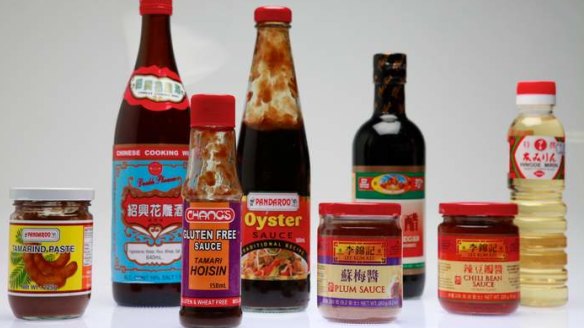Sticky business: a guide to Asian sauces and ingredients
Demystifying the Asian store cupboard.

Asian grocers tell the story of multiculturalism in Australia. Even small stores are packed with kitchen staples from China, Vietnam, Thailand, Cambodia, Malaysia, Japan and India, representing waves of migration dating back to the gold rush.
It can be hard to resist filling a basket with the intriguing and often inexpensive bottles, jars and packets that line the shelves. But once you've lugged them home, how do you use up the sticky bottles that gather in the fridge?
Chef and food tour leader Allan Campion, former Rockpool head chef Katrina Ryan (now of the Golden Pig food and wine school in Brisbane), and Malaysian-born cooking teaching Tony Tan offer some tips and tricks.

Plum sauce
This sticky sweet-and-sour sauce made from preserved plums, ginger, chillies and vinegar keeps almost indefinitely in the fridge. It's often too sweet on its own, but mixed with ingredients such as soy sauce, hoisin sauce and garlic makes a good dip, sauce or marinade.
Try: Make a dressing for roast duck, chicken or pork by combining a little plum sauce, soy sauce, lemon juice and oil. Simmer tomato passato with the same amount of plum sauce and a splash of fish sauce and serve with roasted pork belly. Saute chopped fresh plums and star anise in caramelised palm sugar and shaoxing, stir in some plum sauce and serve with roast duck.
Hoisin sauce
A little thicker and stickier than tomato sauce, this sweet red-brown sauce made from soy beans, garlic, vinegar and spices is used to add a sweet roundness to sauces and marinades. It goes especially well with pork. Thin with water to get the consistency you want.
Try: Serve rice-paper rolls with hoisin combined with lots of crushed dry-roasted peanuts. Marinate beef ribs in hoisin, black pepper, five spice, spring onion, ginger and garlic. Drizzle over kim chi pancakes.
Oyster sauce
A dark brown umami-rich sauce made from oysters and soy sauce, it's good in stir-fries, marinades and as a dressing for steamed vegetables. Ryan and Campion recommend the Megachef brand, made from smoked Thai oysters, which contains no MSG or artificial flavours. Once opened, store in the fridge.
Try: Mix oyster sauce with chilli sauce, chopped fresh chillies and garlic and serve with Chinese-style roast pork. Stir-fry prawns, calamari and mussels, add oyster sauce, coriander and shredded ginger and immediately serve over steamed sticky rice. Rub oyster sauce and salt on a rump steak, leave at room temperature for 30 minutes, then barbecue.
Kecap manis
This sticky, treacly soy sauce is sweetened with palm sugar. It adds a sweet-salty complexity to Indonesian dishes such as nasi goreng and mee goreng, along with stir-fries, marinades and braises.
Try: Stir-fry tempeh with kecap manis, sliced onions and chilli. Finish with a squeeze of lime juice.
Marinate pork neck in kecap manis, plum or hoisin sauce, grated ginger, chopped garlic and a few drops of sesame seed oil and slow-roast or barbecue, basting with the marinade as it cooks. Barbecue cuttlefish tossed in kecap manis with a little salt or soy sauce and serve with green papaya salad.
Chilli jam
Labelled "Chilli paste with soya bean oil", chilli jam is made with caramelised chillies, shallots, ginger, garlic, fish sauce and sugar. Campion adds a dollop to sauces, stir-fries, marinades and soup any time they're missing oomph. "Because it brings so many flavours in one hit, you don't need a lot of it." Make your own or look for Pantainorasingh brand.
Try: Fry prawns or calamari in chilli jam and add a handful of basil and kaffir lime leaves. Marinate chicken wings in chilli jam and honey before roasting. Finish with lime juice. Make dressing for prawns with chilli jam, coconut cream, fish sauce, palm sugar and lime juice.
Chinese rice wine (Shaoxing, shao hsing)
Every home should have a bottle of versatile Chinese rice wine, says Tan. Sweet and acidic, it's made from fermented glutinous rice or millet. It's used to tenderise meat and seafood in marinades, adds flavour to steamed dishes and stir-fries and is an essential ingredient in China's famous "drunken" dishes.
Try: Add a sweet smokiness to a stir-fry by flaming off the alcohol in the wok after par-cooking the other ingredients (see http://www.goodfood.com.au/good-food/cook/mastering-the-stirfry-20130204-2dtdc.html). Balance the saltiness in fried rice by adding 1 tablespoon shaoxing mixed with 1 teaspoon sugar. Combine with soy sauce, ginger and spring onions and pour over fish before steaming.
Mirin
This versatile sweet and acidic Japanese rice wine is good in dipping sauces, stir-fries and marinades. Mirin, dark soy sauce, sake, and sugar are traditionally boiled together to make a glaze for teriyaki meat or fish ("teriyaki" is a combination of teri, meaning glaze, and yaki, grill).
Try: Whisk together mirin and white miso and use to dress fish steamed with spring onions and ginger. Add to a pork stir-fry. Marinate chicken drumsticks overnight in mirin, soy sauce, garlic and ginger, then roast for 30 minutes. Finish with a squeeze of lemon juice.
Chinese black vinegar
Dark as ink, with a complex sweet, malty sharpness, black vinegar is China's answer to balsamic. "If you've never tried it, it's a revelation," says Campion. It's good in braises, soups and stir-fries and as a dipping sauce for dumplings.
Try: A few drops with vongole or pipis stir-fried with lots of spring onion and ginger. Blend mirin, chopped garlic, soy sauce and black vinegar with olive oil to dress a simple lettuce and tomato salad. Drizzle firm tomatoes with a little black vinegar, roast them in a hot oven until they soften and dress with olive oil and roasted sesame seeds.
Tamarind paste
Sold in a block, the pulpy sweet-sour fruit of the tamarind tree can be used in savoury dishes and desserts. Ryan uses the Cock brand from Thailand. "It has a great unadulterated sour, fruity flavour without the saltiness or muddiness you get from processed tamarind paste in a jar." To use, cut a chunk off the block and soften in boiling water for 15 to 20 minutes, mixing to separate the fibres, then rub the pulp through a sieve. Discard the seeds and use the sieved paste.
Try: Add zing to slow-cooked braised dishes such as beef rendang or massaman curry. Add to a dressing for tea-smoked salmon or trout. Make a sorbet with tamarind and sugar syrup to serve with roasted banana.
Miso paste
A paste made from fermented soy beans, rice or barley, miso comes in various grades but the most common are white, red and brown. It's rich in umami, with a flavour that can be sweet, salty and earthy, sometimes all at once. It's most commonly used in soups but can be added to marinades, sauces, dressings and glazes.
Try: Steam an eggplant, slice in half lengthwise, flash on the grill and dress with a mixture of miso paste, sugar and chopped garlic, and garnish with spring onions and roasted peanuts. Make a quick lunchtime soup with miso paste, chopped spring onions, shredded nori and water. Combine miso with mirin, soy sauce and sugar to glaze baked salmon.
Black beans
Not to be confused with Mexican black beans, these fermented or salted black beans (dow see) are soy beans that have been fermented in salt. They add an appetising earthy-salty flavour to barbecued dishes, stir-fries and braises. Rinse and soak in cold water for five minutes to remove some of the salt before use.
Try: Mix chopped black beans, chilli, ginger and garlic to a paste and rub over a rack of lamb before roasting. Add the same paste to the wok after stir-frying cauliflower florets on a high heat. Sprinkle a few black beans into a green salad instead of olives or capers.
Palm sugar
Sap from various palm trees is boiled down until it crystallises, then formed into rock-hard brown cakes or cylinders. Also known as jaggery or gula melaka, it must be chopped or grated before use in sweet or savoury dishes – anywhere you want a sweet caramel fudge flavour, says Ryan.
Try: Boil 300g palm sugar with 150ml water to make a syrup for custard, rice pudding, sago, ice-cream or barbecued pineapple. Make a marinade with soy sauce, palm sugar, five spice powder and chopped garlic for pork.
Belachan
Also known as blachan or belcan, this stinky paste made from fermented, sun-dried shrimps divides opinion. But a little added to a curry or marinade adds an indefinable base note and umami characteristic. Ryan prefers the Cock brand from Thailand, sold in jars, while Tan prefers blocks of Malaysian belachan. Store in a well-sealed container in the fridge.
Try: Mix a tiny amount to a loose paste with water and add to soups such as laksa, seafood chowder or bouillabaisse for a huge flavour lift. Add to the wok when you're making chilli crab. Wrap a little in foil and roast then add to a ginger, soy and cornflour marinade for chicken pieces.
Allan Campion is the co-author of Chilli Jam: Choosing and Using Asian Ingredients (now out of print). He leads walking food tours in Melbourne. Visit http://melbournefoodtours.com/
Katrina Ryan runs the Golden Pig food and wine school in Brisbane, which offers hands-on cooking classes. Visit goldenpig.com.au
Tony Tan is a chef and cooking teacher. He is leading a food tour of Vietnam in August. Visit tonytan.com.au
Recipes from the Good Food database:
Plum sauce recipes
Adelaide Oval’s famous plum chicken (Jill Dupleix)
Spring rolls with crab, sweetcorn, tofu and wood ear fungus (Karen Martini)
Hoisin sauce
Lamb and mushroom stir-fry with hoisin sauce (Neil Perry)
Roast duck rice paper rolls (Neil Perry)
Oyster sauce
Chinese-style prawns and eggs with oyster sauce (Adam Liaw)
Wok-fried steak and broccolini with oyster sauce (Adam Liaw)
Kecap manis
Nasi goreng (Jill Dupleix)
Chilli jam
Thai chilli jam (Brigitte Hafner)
Coconut-grilled chicken with green mango salad and chilli jam (Teage Ezard)
Chinese rice wine (Shaoxing, shao hsing)
Ma Po Tofu (Neil Perry)
Chinese wine-simmered duck (Brigitte Hafner)
Mirin
Grilled prawns with yuzu dressing (Jill Dupleix)
Chinese-style dry-seared beans (Steve Manfredi)
Chinese black vinegar
Steamed wontons with black rice vinegar (Jill Dupleix)
Cantonese-style sweetcorn and crabmeat soup (Stephanie Alexander)
Tamarind paste
Lentils with tamarind sauce (Neil Perry)
Pork and noodle stir-fry (Caroline Velik)
Massaman curry (Brigitte Hafner)
Miso
Baked eggplant with miso (Caroline Velik)
Wasabi pea-crusted tuna (Jane and Jeremy Strode)
Black beans
Steamed fish fillets in black bean sauce (Elizabeth Chong)
Steamed spare ribs with black bean (Jill Dupleix)
Palm sugar
Deep-fried banana roll with coconut ice-cream (Tony Tan)
Calamari with chillies and basil (Steve Manfredi)
Belachan
Chicken kapitan with fragrant rice (Neil Perry)
Peanut and Pork Curry (Fiona Smith)
Roasted barramundi with hot and sour Thai caramel (Karen Martini)
The best recipes from Australia's leading chefs straight to your inbox.
Sign up- More:
- How to
